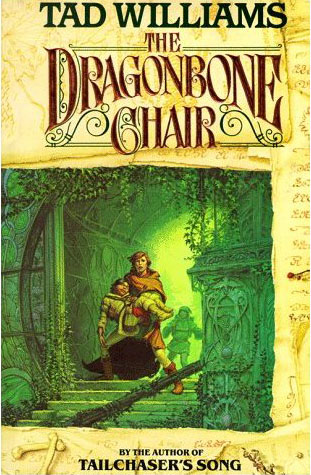I’d hinted I was interested in doing something like this elseweb, and here I am doing it: re-reading Tad Williams’ late 1980s/early 90s work of epic fantasy, the Memory, Sorrow, and Thorn trilogy. This is in part because we’re going to get a new trilogy, The Last King of Osten Ard, starting in spring 2016.
But it’s also because I have a history with this trilogy, one that leads directly to my writing fantasy today. These books turned me on to the sort of fantasy that is viscerally immersive and complex, extended outside the page with glossaries and language guides and in-world texts and gorgeous Michael Whelan cover art.
The Dragonbone Chair was first published in 1988, when I was eight years old. I didn’t read it then; I was around thirteen when I did. The final volume, To Green Angel Tower, was only out in hardcover when I started reading; I have the edition that is all one ginormous hardcover, rather than two paperbacks.
I read those first two books with the final volume hanging over my head like an exquisite promise. It was the name, you see: To Green Angel Tower. You know from page one that Green Angel Tower is the massive, vertigrised Sithi-built tower that still stands in the Hayholt, the castle where the story begins — and, as the title promises, ends.
(There’s a crash course in literary resonance, kids).
I remember distinctly the day I started reading The Dragonbone Chair for the first time. I was sitting on my parents’ bed in the loft of the log cabin where I grew up, the fan whirring loud and metallic beside me, as I read of Simon sparring with Rachel the Dragon, the fierce Mistress of Chambermaids in the Hayholt.
Last night, on a day that was not summer nor quite fall, with the moon in eclipse, I read the same scene again. I had scarcely opened the books since that day twenty plus years ago; I had replaced my battered paperback copy of The Dragonbone Chair with an equally battered library hardcover.
I perused the ephemera, which meant more to me now. God, Williams looks so damn young in his author picture. I can’t find it on the interwebs to share with you all, but he must have been the age I am now. It’s especially striking next to his current author picture..
The glossary was not as extensive as I recalled it being — but then, it does expand in future volumes, as does Simon’s knowledge of the world. But there are those delightful Qanuc sayings I loved, i.e. “if it falls on your head, then you know it’s a rock.”
And… well. I suppose I’ll just point you to my tweets from then on:
I only got about two chapters in before sleep overwhelmed me. It was no fault of the writing, I assure you, only the fact that I was coming off a larp weekend.
Although, speaking of the writing, it has a certain naive awkwardness you probably couldn’t get away with in fantasy today (omniscient third person, a lot of “as you know, Bob”-type conversations). But oh god, the descriptive language is fabulous. He was the Pat Rothfuss of his day.
Anyway. I invite you to join me in my re-read — even if it’s your first time through! I’ll be checking in here occasionally, as the mood strikes me, but primarily my musings will be found on Twitter at the #LiseRereadsMST hashtag.
